To 3D Or Not To 3D: Buy The Right Toy Story 3 Ticket
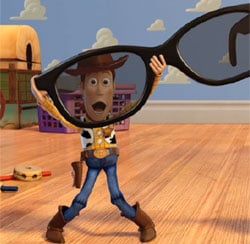
The biggest question any potential moviegoer faces at the box office right now isn't which movie to see, but how to see it. Toy Story 3 opens in 3D this weekend and if you've read my review you know that I think it's the best movie of 2010. That makes it even more important that you choose the right way to view. Going 3D for the newest Pixar masterpiece might seem like a no-brainer, but just because something's more expensive doesn't always mean it's the best possible experience.
Before you buy a Toy Story 3 ticket, we want you to be sure you're buying the right ticket. To help, I've developed an unbiased, seven-point system for determining whether 3D is the right choice for you. If you want an opinion on the film itself read my glowing review, but here we're talking about something different. In order for this analysis to work, my intent is to ignore the quality of the film as a whole and instead give an analysis of the movie's 3D on a mostly technical level. Using that, we'll give you the tools you need to buy the right movie ticket in the right format, and at the right price. Read on.

Is 3D A Fit?
Pixar movies are ideal candidates for 3D enhancement, since 3D always works better on the sharply defined lines of computer animation. It also helps that Pixar's films, and the Toy Story movies in particular, generally use bright, sharp colors. Even without 3D enhancement the colors and shapes of a Toy Story movie tend to pop out of the screen, which should make it pretty easy for 3D to add even more depth and texture to what's already there. The only thing which really stands in the way of making Toy Story 3 a perfect 3D candidate is the film's story. These movies usually take place on a smaller scale, we're talking about toys under a table here, not aliens leaping and running through a planet-sized jungle or a boy riding a dragon through an endless sea of clouds. Can you succesfully render Buzz and Woody in 3D? Sure. Should you? I'm not so sure.
3D Fit Score: 3/5
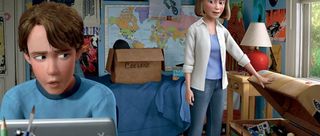
Plan Ahead: 3D Works Better With Effort
Pixar's movies are all brilliant, technical achievements, but the first concern of their creative team is always story. That's how Toy Story 3 was developed and when they wrote it, no one involved in the writing had 3D in mind. I'd rather have it that way, the important thing here is that they're telling a great story, whether or not it works for 3D should be irrelevant and that's exactly how this movie was conceived. Unfortunately it also means that maybe this story isn't really designed for 3D and indeed, in a less 3D-obsessed climate, I have a hard time believing that Toy Story 3 would ever have been released in 3D at all. On a technical level, though, they planned ahead and after the movie was written and headed into development, they had their 3D processes laid out ahead of time, of that you can be sure. Toy Story 3 wasn't rushed into a 3D conversion at the last second, but it seems clear that the script at least, was written with great storytelling in mind, not great usage of 3D gadgets.
Effort Score: 3/5
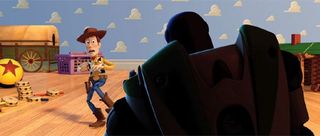
Maximized Depth
CINEMABLEND NEWSLETTER
Your Daily Blend of Entertainment News
One of the problems with using 3D on a movie like Toy Story 3 is that there's just not a lot to give depth to. Much of the movie takes place in confined spaces and while they do a good job of adding depth to those, I'm not sure how much we needed it. But in the latter half of the film there's a scene which takes place in a massive, outdoor environment with objects swirling and plummeting down into a fiery hellhole, and the film's 3D is incredibly effective there at drawing you down into the moment as if you're really staring into something from a great height. Mostly though, the depth of 3D is used to give more dimension to the film's characters. It does that well, but since these are plastic toys we're talking about, in the process it only ends up making them seem more plasticky. One of the challenges in doing a Toy Story movie is to make plastic, stiff, lifeless objects look as though they're alive. 3D seems to work against that goal, by highlighting the artificial nature of the movie's characters while the film itself is aimed at making them come alive.
Picture Depth Score: 3/5
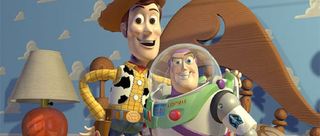
Light It Up
Director Lee Unkrich has created a bright, high-contrast film, which means picture brightness should be no problem for 3D viewers… as long as you're in a theater which knows how to properly project 3D movies. In order for a 3D movie to look right when seen through those filtered lenses you're putting on your head, the picture must be projected with greater brightness than that normally used on a 2D picture. Unfortunately, far too few movie theaters actually go through the trouble to crank up the brightness on their projectors, which could mean that even though the folks at Pixar have done their job, you'll see the movie in an inferior fashion when you buy a 3D ticket.
It was a real problem during my 3D showing. A week earlier I'd watched an extended clip from Toy Story 3 in 2D, projected by the amazing digital projectors at Cinetopia, one of the best theaters in the Pacific Northwest. The picture was luxurious and even in 2D the colors were so vibrant it felt like I was falling into the screen. Stunning. A week later I viewed the entire film in 3D, projected at a different theater, but without increased brightness. The difference between viewing that same scene in 2D and improperly projected 3D was glaring. The 3D version of the film felt far less vibrant, some of the colors were lost, and what I saw was an inferior product.
Pixar has done their job here and created the right kind of light environment in their film for proper 3D viewing, so I'm giving them high marks. But that doesn't mean your local theater will do their job in projecting the movie the way it ought to be seen. Your experience may vary drastically, depending on where and how you see it.
Brightness Score: 5/5
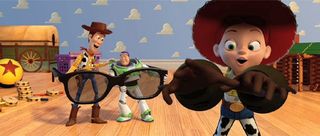
Gimmick Me!
There's a right way and a wrong way to do this. Done right, beautiful Pandoran seeds float over the heads of the audience to further immerse them in what's going on. Done wrong, a character waves a broom handle at the crowd and distracts them from what's going on. But Pixar isn't interested in gimmicks and while stuff flying out of the screen can be fun and a useful 3D tool, they don't do it. In part this is a symptom of how the movie was created. It wasn't written with 3D in mind so it makes sense that the movie doesn't really contain any of those big, wow-factor 3D moments. They simply tell a story and it happens to be projected in 3D. It's not in 3D because the story demanded it, it's just in 3D because that's the way things in the industry are going. You'll get no extras.
Gimmicky Fun Score: 1/5
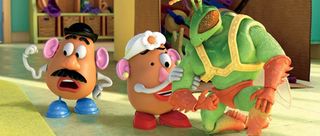
How Do You Feel?
Because the movie's so good and because you'll be so invested in what's happening, the film's 103 minutes of running time flies by like it's not even happening. You'll be too focused on the film to experience any of the usual 3D fatigue. It also helps that Pixar doesn't ever do anything halfway and on a technical level their 3D is first rate. While a lot of people walked out of the theater crying at my showing, no one seemed to be complaining of any sickness or headaches or dizziness, the way so many people often do when they walk out of a screening. Of course my observations on this are only anecdotal and it's hard to gauge how Toy Story 3 in 3D will affect you since different people will be affected differently. But because of the film's relatively short running time, the technically proficient way in which it's put together, and the complete lack of 3D camera gimmicks, the odds are in your favor on this one. I'm willing to bet you'll walk out feeling fine.
Audience Health Score: 5/5
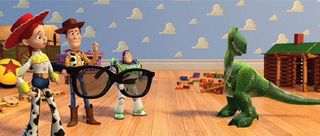
The Glasses Off Test
If you've ever taken your glasses of while watching a good 3D movie, you probably noticed that during the most 3D intensive parts of the film, the picture on screen became even fuzzier. The simplest way to explain this is to say that the blurrier the image on screen appears when seen without glasses, the deeper and more vibrant the 3D is likely to be with your glasses on. So to test this, I removed my glasses periodically during Toy Story 3 to examine the way the movie's 3D effects were being created. The film was utterly unwatchable without my glasses on, which means Pixar was taking full advantage of the 3D format throughout the film. It became even blurrier during wide shots, indicating they were properly using 3D to add greater depth as the camera zoomed out. Pixar has done their best to make full use of 3D here, they're doing their best to give you your money's worth.
Glasses Test Score: 5/5
| SCORES RECAP | |
| 3D Fit | 3 |
| Effort | 3 |
| Depth | 3 |
| Brightness | 5 |
| Gimmicky Fun | 1 |
| Audience Health | 5 |
| The Glasses Test | 5 |
| Total Score | 25 (out of a possible 35) |
Final Verdict: Pixar's team has done a technically proficient job of making a 3D movie out of a story that probably didn't really need to be in 3D. Maybe you won't regret it if you pay the extra money to see it in the 3D format, but for my second viewing, I'm making it a point to catch it in 2D. While the 3D is well done, it doesn't really add anything to the story. If you want to play it safe, see it in 2D.
For more 3D analysis, visit our To 3D Or Not To 3D archive right here.
Most Popular







